Log in or create new account to save this product to your wishlist.
Identifying Common Garden Weeds in the UK: A Comprehensive Guide
Weeds can be a nightmare. Or they might be a blessing. This article will help you decide!
Latest articles
7 MIN 22 Jul How to keep your lawn in shape this summer 9 MIN 15 Jul Watering Your Garden: 10 Top Tips! 11 MIN 15 Jul Is Your Grass Type Right for your Garden? 11 MIN 10 Sep Create Your Low-Maintenance Garden – Tips and Ideas 11 MIN 08 Sep The Ultimate Guide to Choosing the Perfect Hedges for Your Garden 12 MIN 30 Aug The Top 20 Evergreen Climbers to Transform Your GardenWeeds are wildflowers that appear in unwanted places — but how can you tell between a “weed” and a plant you want in your garden? On the one hand, a common thorn in one’s side, but on the other, a beautiful plant. Common garden weeds in the UK – a nightmare or a dream – you decide.
- What are weeds?
- Where do weeds occur?
- How do weeds spread?
- Types of weeds
- The most common weeds in the UK (and how to recognise them)
- Celandine
- The drawbacks of weeds
- The benefits of weeds in your garden
- How to remove weeds from your garden
- FAQs
But weeds have had a bad rap over the years. And sometimes, we should embrace the wild and allow them to live and spread around our gardens.
This article is all about weeds and their ability to survive against the odds.
What are weeds?
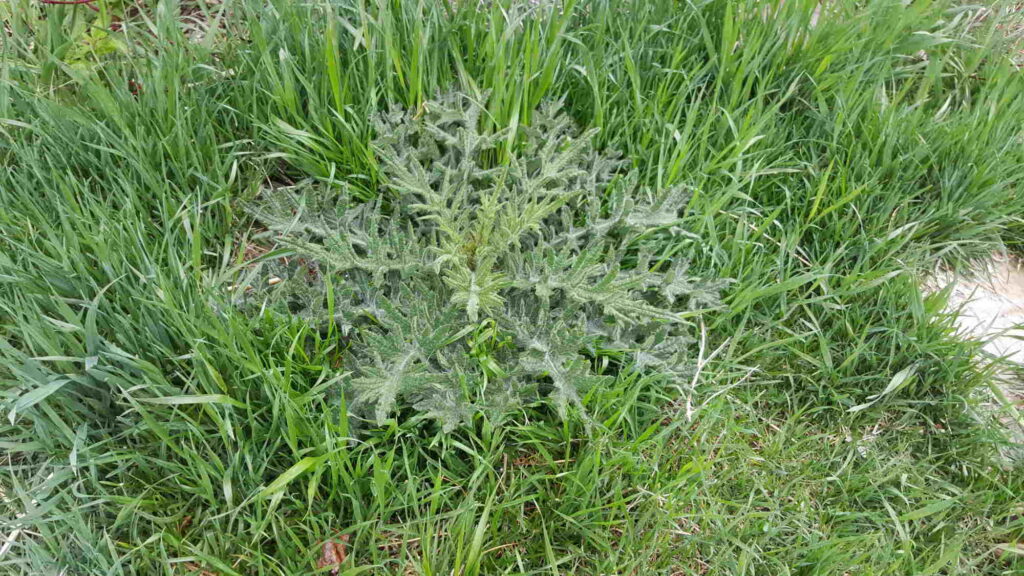
Let’s get straight to the point here: there’s no clear objective definition of a weed. Because what one person labels a weed, another person encourages because they provide pretty flowers that attract beneficial bees and insects.
The most helpful definition, perhaps, is that a weed is simply an unwanted plant — one that appears rather than grows as a result of cultivation.
So, in theory, any plant species could be considered a weed. What is “undesirable” depends on your preference. For example, the beautiful aquilegia spreads around your garden like wildfire — but you’ll never regret allowing those self-seeders to infiltrate your garden.
Lawn doctor Louis says:
In principle, any plant species could be considered a weed. Most people think weeds are plants that simply appear, spread, and self-seed.
Where do weeds occur?
Weeds tend to appear where you least want them: in your lawn, your flowerbeds, or in between the cracks in your patio.
Self-seeding weeds tend to have an aggressive character — they take over the soil and draw nutrition from the plants you’ve chosen.
So, while not all weeds are bad, some will dominate your garden.
How do weeds spread?
Most weeds are self-seeders, meaning their seeds spread in the air or are dispersed by animals. For example, squirrels collecting nesting materials from around your garden helps disperse seeds as they stick to their fur, and dogs running around the garden transfer weeds from one area to another.
But the biggest culprits are birds that excrete undigested berry seeds while in flight, which land in your garden.
Some seeds with panicles (or wings), such as the dandelion and sycamore, float in the wind for wide distribution. The faded dandelion transforms into a ball of white fluff, and when ripe and ready, they’re ripped from the plant by a gust of wind, landing up to 10 metres from the plant.
However:
A great bit of trivia for a pub quiz: the best conditions for dandelion seed dispersal is a calm, sunny day which creates thermal updraughts allowing wider distribution — not windy days (which tend to direct the seeds downwards). In warm, still conditions, around 1 in 7000 seeds travel up to a kilometre!
So, yes — seed dispersal is a problem!
Types of weeds
Root weeds have extended, deep root networks, which are often the most difficult to remove from your garden. This is because even a small amount of root that survives can regrow into a new plant.
Examples of root weeds are:
- Thistle
- Nettle
- Bindweed
- Horsetail
- Japanese knotweed
- Ground elder
- Creeping buttercup
Examples of self-seeding weeds are:
- Dandelion
- Daisy
- Green alkanet
- Herb bennet
- Oxalis
- Herb Robert
- Lesser celandine
Almost without exception, these weeds can add attractive colour and texture to a flowerbed. But they will take over if left to their own devices.
The most common weeds in the UK (and how to recognise them)
There are hundreds of species of weeds commonly found in the UK. However, these are the nine most commonly found in gardens.
Thistle
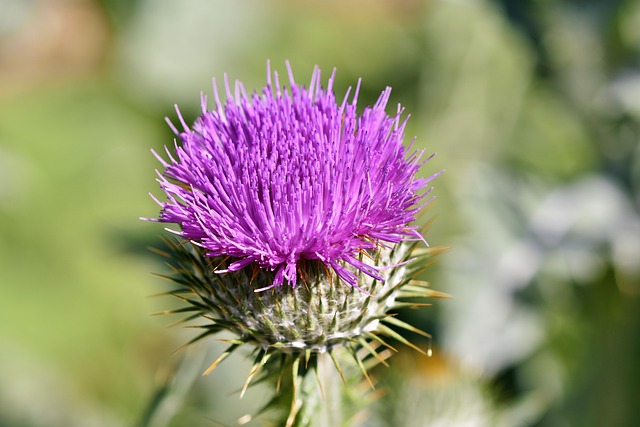
There are many types of thistle to be found in the UK, from the characteristic thistle found on the back of a Scottish £50 note to thistley weeds found growing in bald patches on your lawn.
Traditional thistles are easy to spot:
- Large, prickly leaves
- Small, purple, prickly flowers
While they’re attractive plants, thistles can consume a lot of soil nutrients, so you won’t want them in your lawn. It’s no fun to walk barefoot on your lawn and come across a thistle underfoot, after all.
Clover

Clover is a hard-to-fight herb that even survives the frostiest of British winters. You’ll recognise clover by the unmistakable three-leafed clusters.
Most clover varieties bloom in the summer, producing small, cute white or purple flowers that resemble bed hair after a night out. These are a good source of nectar for insects, so they’re by no means an unwelcome addition to your garden.
Check out our expert guide to removing clover from your lawn for more information about this attractive weed.
Dandelion
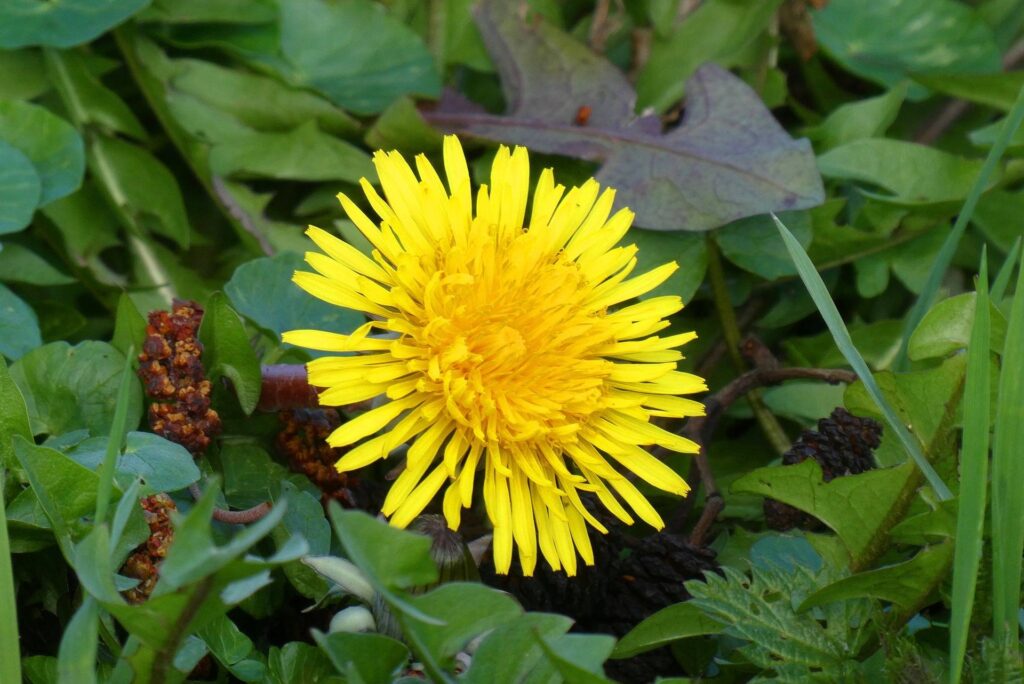
These jolly yellow flowers are instantly recognisable in their flowering and seeding form. The fluffy seeds scatter in the breeze, and before you realise it, your lawn and flowerbeds are full of them.
Again, dandelion flowers are attractive to bees and other pollinators during the spring. So, if you want to kill off the plants, wait until the flowers have faded before your tackle the plant.
You’ll need to remove the whole root; otherwise, it will grow back.
The best defence against dandelions in your lawn is to maintain as dense a grass structure as possible. So, scarify and overseed every year to keep your grass plants healthy and lush.
Stinging nettle
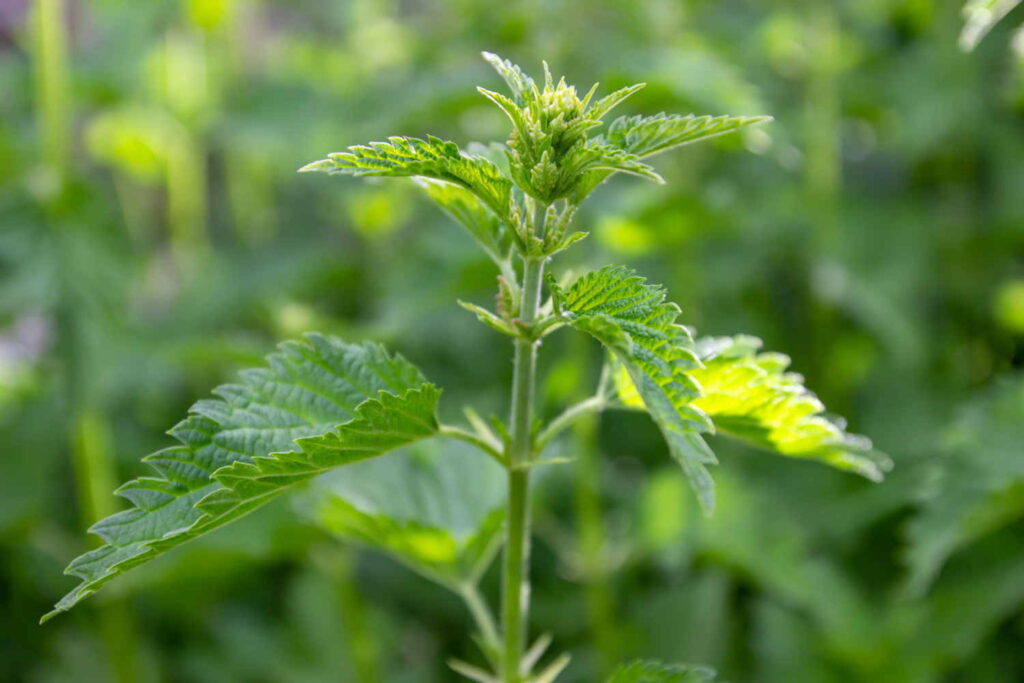
There can’t be an adult who didn’t fall into a bush of stinging nettles at some stage of their childhood. And that’s what gives this hardy perennial its fearsome reputation.
But, again, nettles are a boon for insects, especially butterflies, which lay their eggs between the plants. And they’re edible for humans, brimming with vitamins and minerals.
Nettles are most recognisable by their:
- Serrated leaves
- Burning hairs (when making skin contact)
So, while nettles can be a pain, they’re great for your garden’s biodiversity.
Daisy
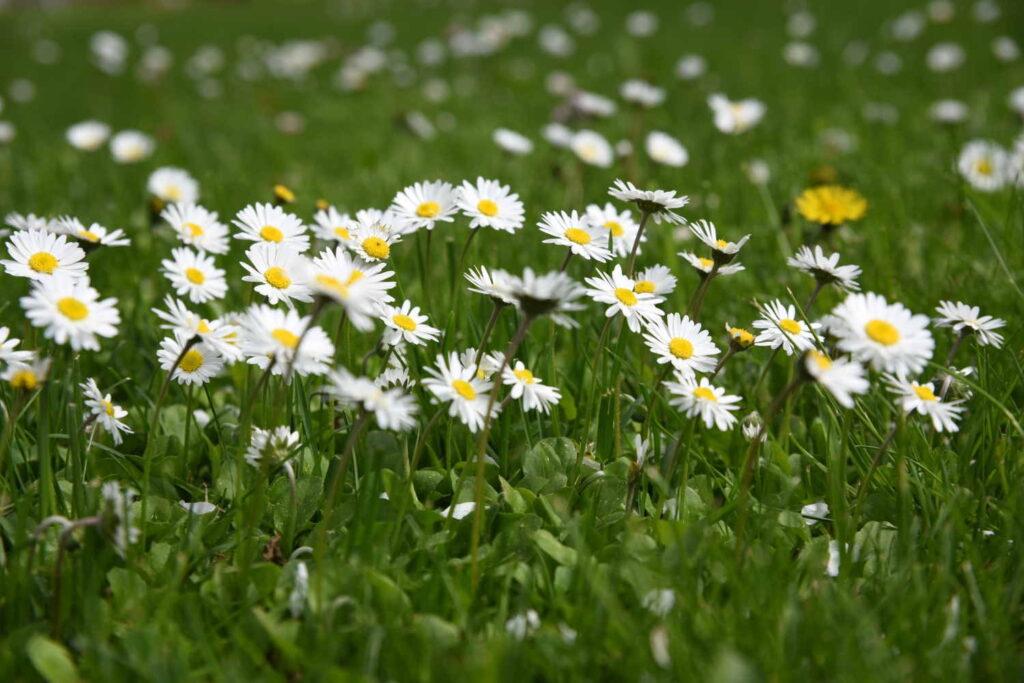
Daisies produce pretty little blooms all year round until the frost hits. They’re recognisable by their:
- Yellow head
- Rosette-shaped leaves
- Long, green stems
The daisy reproduces quickly and can create attractive coverings over your lawn. However, you might want a weed-free lawn — follow these expert tips.
Buttercup
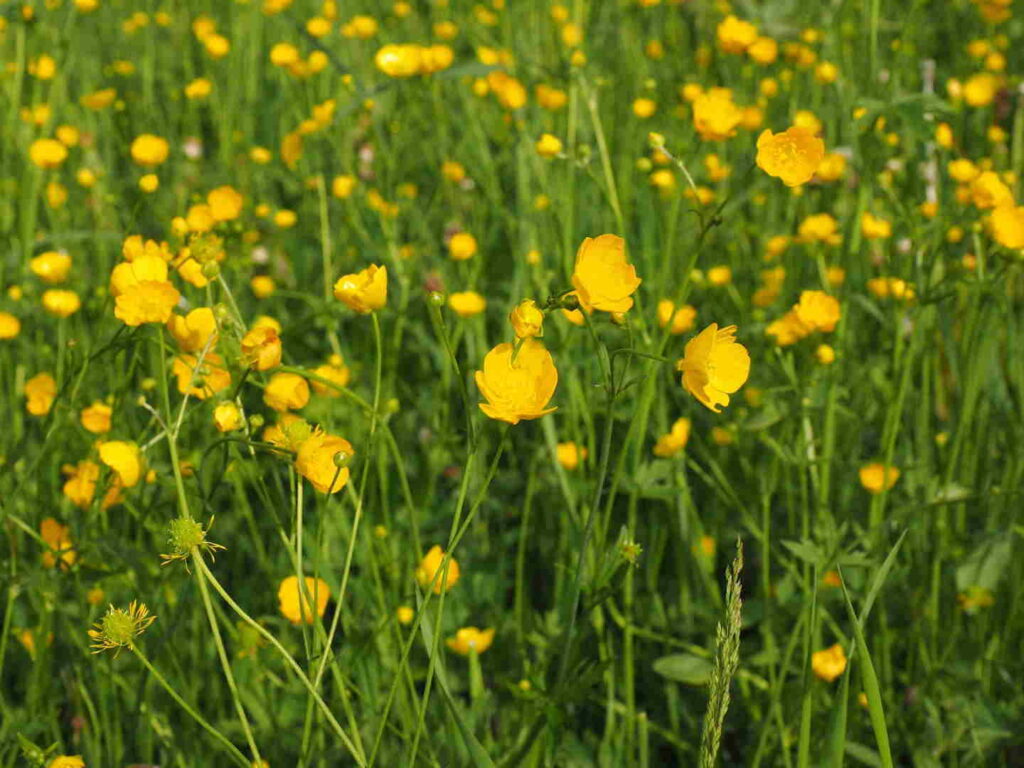
Contrary to childhood belief, you can’t tell if someone likes butter by the glow of a buttercup underneath their chin. I mean: who doesn’t like butter?
However, these cheerful, vibrant yellow flowers may look innocent, but nothing could be further from the truth. Because the buttercup strips nutrients from the soil, negatively impacting surrounding plants.
In moist soils, buttercups reproduce at breakneck speed, both through their deep root networks and seeds from faded blooms.
So, despite the jollity they may bring to your garden, you might want to do something about them before they spread. But, again, buttercups attract pollinating insects, so keep them under control if they’re present in your garden.
Hedge bindweed
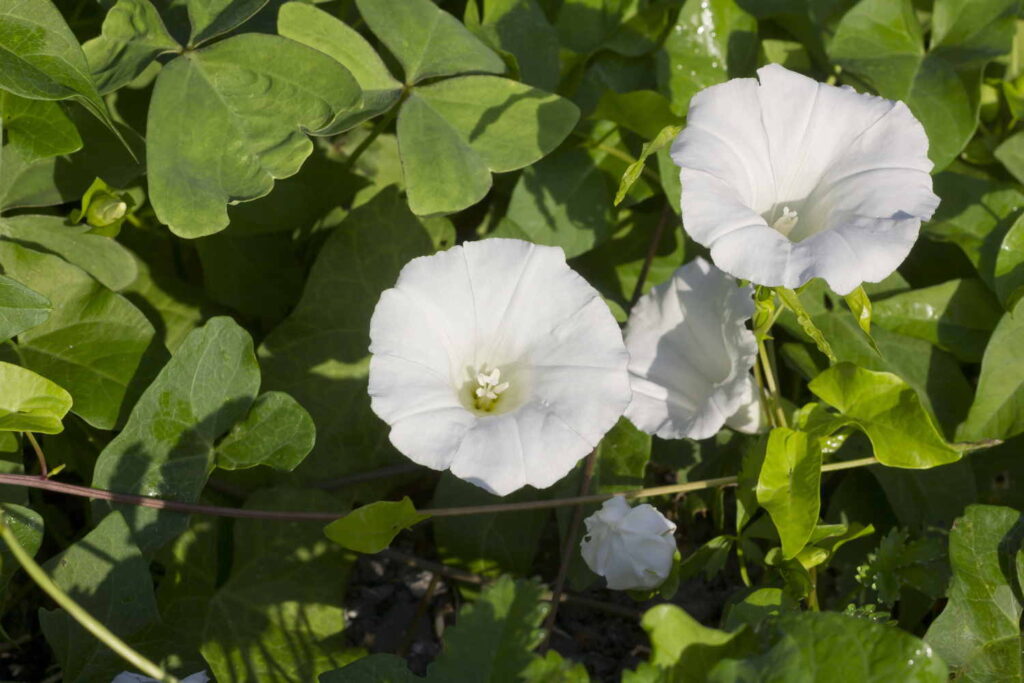
Known by a variety of regional names, the hedge bindweed is also known as the Rutland beauty, heavenly trumpets, and even the granny-pop-off.
You’ll recognise the granny pop-off by its broad but thin leaves and cute white flowers.
However, hedge bindweed spreads rapidly and can suffocate other plants. The brittle rhizomes break easily, which makes these weeds challenging to remove.
Celandine
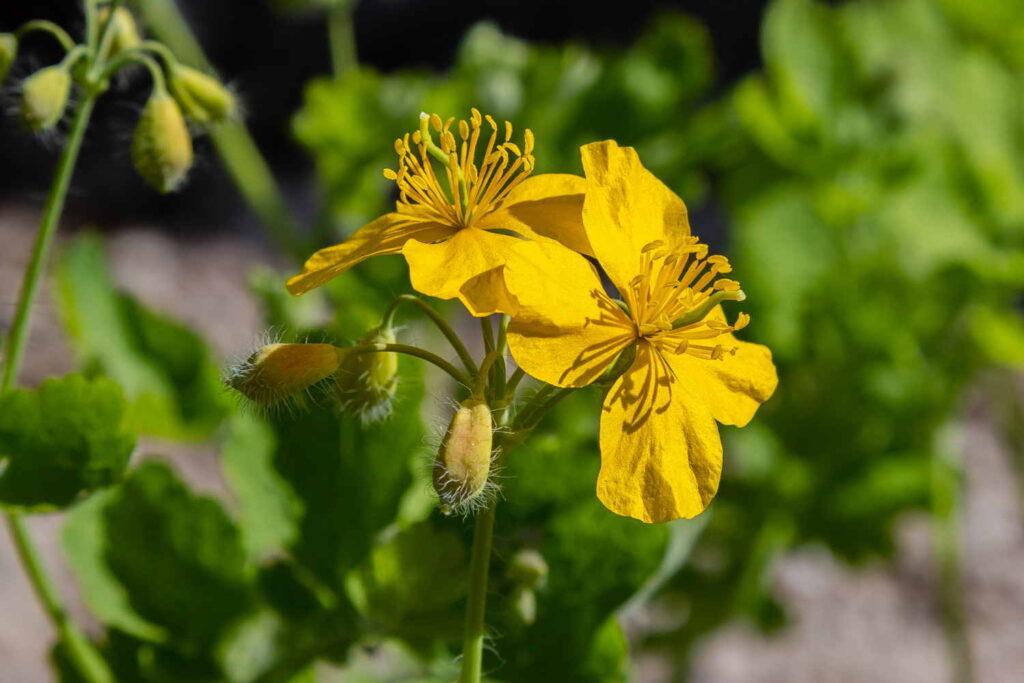
The celandine is a member of the buttercup family, which spreads enthusiastically in woods, hedgerows, and around streams. However, they’re often found in gardens and provide an excellent pollen and nectar source for bees, flies, and beetles.
Traditionally used to calm down digestive problems, the greater celandine plant is sometimes used for upset stomach, IBS, and constipation. However, the more common lesser celandine found in gardens is mildly toxic if ingested raw.
So, steer clear!
You’ll recognise them by their:
- Clusters of yellow flowers
- Flowers grow in groups of four
- Blue-green-coloured leaf underside
Street grass (Poa annua)
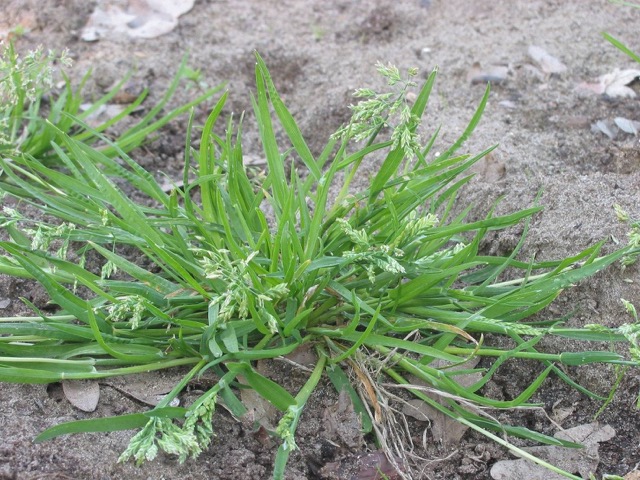
Street grass stems from a cross between two other weed grasses: Poa infirm and Poa supina. You’ll recognise street grass from its:
- Pale green colour
- Panicle heads
This is likely to appear in a weak lawn — that’s a lawn that hasn’t been regularly scarified, overseeded, and fertilised. And once street grass has taken root, it can be difficult to remove.
So, the best defence is to maintain the strongest lawn you can.
Check out our expert guide to weed grasses for more information.
The drawbacks of weeds
Obviously, weeds can cause many problems, despite the positives they bring to your garden. For example:
Weeds overgrowing grass and plants
One of the most significant problems can be that weeds overtake the growth of the plants you have chosen for your garden. They extract nutrients from the soil and can negatively impact surrounding plants, which could slowly die without further action.
Weeds can be harmful
While most weeds are entirely benign, some cause skin irritation and rashes, such as nettles, poison oak, and poison ivy.
Weeds spread quickly
Weeds are fast spreaders, especially if they’re self-seeding. Before you know it, they’ve taken over your garden or allotment.
Removing weeds is hard work
Finally, the proverb “weeds do not perish” is pretty much true. Fighting weeds requires a fair amount of prolonged effort because many varieties are exceptionally hardy.
But fear not. Many weeds are edible, but if you want to get rid of them, check out our expert guide to controlling garden weeds.
The benefits of weeds in your garden
You might be getting a sense that not all weeds are undesirable. And that’s definitely the case because:
Weeds tell you about your soil
Okay, if your weeds are talking to you, maybe you’re indulging in the wrong kind of weeds or fungi.
For everyone else, the weeds that appear in your garden provide essential information about your soil health.
The types of weeds that appear tell you:
- What type of soil you have
- The condition of the soil
For example, cow parsley enjoys moist, shady, and nutrient-rich soil, while nettles, street grass, and shepherd’s bag only grow if the soil is nutritious.
A range of clovers only appears in nitrogen-rich soil with a neutral pH, while coltsfoot grows in soil with a poor structure.
And dandelions are attracted to the sun, so you’ll be able to see which parts of your garden get the most (and least) direct sunshine.
Weeds contribute to biodiversity
Weeds offer a valuable food source for beneficial insects while scaring off some harmful pests that don’t like the odours released from weed flowers.
Weeds are healthy
Weeds are often edible, although I’d always recommend caution and never eating anything if you’re uncertain of its provenance.
You can use garden weeds for:
- Nettle soup or tea
- Salad leaves (clover, dandelion leaves)
- Roots for stews
How to remove weeds from your garden
Well, this article is more about celebrating weeds for their diversity. But sometimes, you just need them gone.
So, check out MOOWY’s range of articles exploring how to tackle garden weeds.
FAQs
Garden weeds grow in gardens and compete with desired plants for resources. Some common garden weeds include crabgrass, dandelions, clover, and bindweed. Look for key characteristics such as leaf shape, flower colour, and growth patterns. For example, dandelions have jagged leaves and bright yellow flowers, while crabgrass has a sprawling growth habit and coarse, pointed leaves.
Inspect your garden regularly and remove any weeds you find by hand or with a tool. Mulch the soil to create a barrier that inhibits weed growth. And plant your desired plants closely together to crowd out weeds and reduce available space for them to grow.
Weeds serve as a habitat for beneficial insects and provide pollen and nectar for pollinators. Some weeds can improve soil quality by healing compacted soil, which allows water and oxygen to penetrate more easily. While others, like clover, can fix nitrogen in the soil, which can benefit surrounding plants.
Any questions?
I hope you’ve got all the info you need about common weeds in the UK. But if you have any questions, check out our Help & Advice section or send us an email.
We’ll reply as soon as we can!
Thanks for reading!
Leave a comment
Your answer will be displayed on the site and the interested party will be notified by email.
Leave a comment
Have a question or want to share your experience? Leave us a comment.
Read more
The best tips and tricks for a lush green lawn
 7 MIN
13 Sep
Lavender Cuttings: a step-by-step guide
7 MIN
13 Sep
Lavender Cuttings: a step-by-step guide
 11 MIN
10 Sep
Create Your Low-Maintenance Garden – Tips and Ideas
11 MIN
10 Sep
Create Your Low-Maintenance Garden – Tips and Ideas
 Scarifying Kit
All products after scarifying | Quickly restores the lawn after scarifying | Outsmart weeds quickly with the use of this kit
From: € 39.99
Scarifying Kit
All products after scarifying | Quickly restores the lawn after scarifying | Outsmart weeds quickly with the use of this kit
From: € 39.99
 Spring Lawn Care Kit
MOOWY’s choice for the spring | Quick recovery of your lawn after winter | A strong lawn prevents weeds
From: € 25.99
Spring Lawn Care Kit
MOOWY’s choice for the spring | Quick recovery of your lawn after winter | A strong lawn prevents weeds
From: € 25.99
 Long Lasting Lawn Fertiliser
Effective for 90 days | See results in 14 days! | Suitable for all types of grass and soil
From: € 13.99
Long Lasting Lawn Fertiliser
Effective for 90 days | See results in 14 days! | Suitable for all types of grass and soil
From: € 13.99
Do you want a lawn calendar?
🌱 All important maintenance moments for your lawn during the year. Leave your email and we will send you the lawn calendar for free.
Enter your email
Receive the lawn calendar in the mail
Enjoy a green lawn all year round!










Comments (0)
There are no comments yet. Well then, what are you waiting for to
Be the first to write your comment!inaugurate this pretty page?
Do you have some comments?